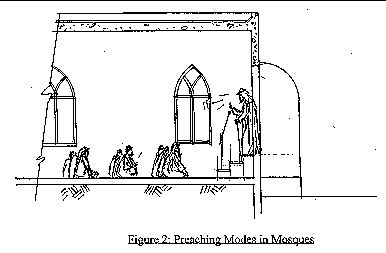Sami A. Khaiyat
Department of Architectural Engineering
King Fahd University of Petroleum & Minerals
Dhahran 31261, Saudi Arabia
Popular version of paper 3pAA5
Presented Wednesday afternoon, December 4, 1996
Third ASA/ASJ Joint Meeting, Honolulu, Hawaii
Embargoed until December 4, 1996
Mosques are multi-function public spaces where various worship activities are performed through various modes of use. There are three distinct activities that are performed in the mosque either separately or in conjunction with one another. One is performing prayers individually or in a group lead by a leader or Imam. The second is attending a preaching being delivered on its own or in conjunction with Friday prayers. The third is to listen or to recite some verses from the Holy Quran. While conducting these activities in the mosque, two general modes of use may be identified as shown in Figures 1 & 2:


| 1. | Prayer mode: | All mosque users are either standing, bowing, or prostrating, always on the same floor level, and aligned in rows parallel to the Qiblah wall, or the front wall, with the Imam or speaker facing away from listeners. |
| 2. | Preaching mode: | The listeners are sitting on the floor in rows parallel to the Qiblah wall while the Imam is standing on a four-step high platform (Minbar) facing the listeners. |
The first mosque in Islam was built in Al-Madinah Al-Monawarah by the Prophet Mohammed, peace be upon him, in the seventh century. It was a simple rectangular mud structure with a central court. Later in history, mosques throughout the world were modeled on this simple building (1). Variation in architectural form, constructional systems, and materials used were dictated by regional, cultural, and climatic differences.
According to the mosque's functions, the greatest determinant upon which its architectural design should be based is its acoustical requirements (2). The optimum acoustical environments in the mosque may be expressed in terms of some basic aural requirements such as:
---Sound audibility, where adequate loudness is to be received by all members of the audience with some degree of uniformity.
---Speech intelligibility, where all speech sounds should be comprehensible irrespective of the position of the listener.
---Full perception of special emphasis laid on some consonants and vowels when reciting Quranic verses.
---Naturalness of the speaker's voice, arising from the ability of the listener to localize the real source and thus maintaining a feeling of realism and naturalness.
Most of the contemporary mosques in Saudi Arabia don't reflect those requirements. They are generally rectangular oblong in shape with great length-to-width aspect ratios and with relatively high ceilings. In addition, every mosque has a prayer niche (Mihrab) and a preacher platform (Minbar) and some times most of the mosques has a centralized dome in the roof as basic elements.(see Figure 3).

Most of the existing mosques in Saudi Arabia have sound-reflecting finish materials on all surfaces, except the floor area which is usually carpeted. They have wooden doors and large single glazed windows.
Due to the harsh climatic conditions in most of Saudi Arabia, active air conditioners are becoming a necessity and are no longer a luxury. Most of the mosques have either window-type or a split-unit air conditioning systems in conjunction with ceiling fans.
Environmental noise sources are becoming more complicated nowadays and tend to affect us in more ways than in the past, especially in Saudi Arabia. Before the introduction of electricity and the automobile, the sources of environmental noise were mainly animals used for transportation, people talking and working, and wind noises. There were no traffic noises or overhead aircraft or air conditioners or fans or televisions or radios or even machinery noises from industrial areas.
The Mihrab was initially developed to indicate the direction of Qiblah and to provide the Imam with enough space to be ahead of all other worshippers during prayers as well as to improve the sound signal through reflections. However, current design practices have altered the size and shape of the Mihrab without any considerations to its acoustical implications.
The rectangular shape and large-volume mosques are being retained from the past even though those features are not needed nowadays. In the past the high ceiling, domes, and large windows served as a passive environmental control system that allowed natural ventilation as well as daylight. Also, domes and arches were introduced as structural elements to provide larger spans. Currently, natural ventilation is not used in mosques under today's standards in Saudi Arabia. Moreover, daylight is not as important as it used to be before the invention of electricity and it could be uneconomical in mosques if one considers that 60% of the time in which the mosque is used is during nighttime.
Other factors that emphasize the importance of the acoustical environment in mosques include the fact that only Arabic is used during prayers, even though most Muslims are non-native Arabic speakers. In addition, tranquility is one of the most important qualities for Muslims during prayers and good acoustical environments tend to help achieving such quality. Moreover, sound absorption in mosques is very limited. It is provided through the carpeted floor as well as worshippers. However, different modes of use by worshippers as well as the variation in the number of worshippers attending each daily prayer and Friday prayer greatly affects the total sound absorption in the mosque and therefore makes the control over the length of the reverberation time more complex. All these factors illustrate the importance and need for special acoustical environments in mosques in Saudi Arabia, and thus calls for further investigations of mosque acoustics.
References
1. Ibrahim, H. M. Planning Standards for Mosques (in Arabic), Ministry of Municipal & Rural Affairs, K. S. A., 1979.
2. Hammad, R. "RASTI measurements in mosques in Amman, Jordan" Applied Acoustics, 30, 335-345, 1990.